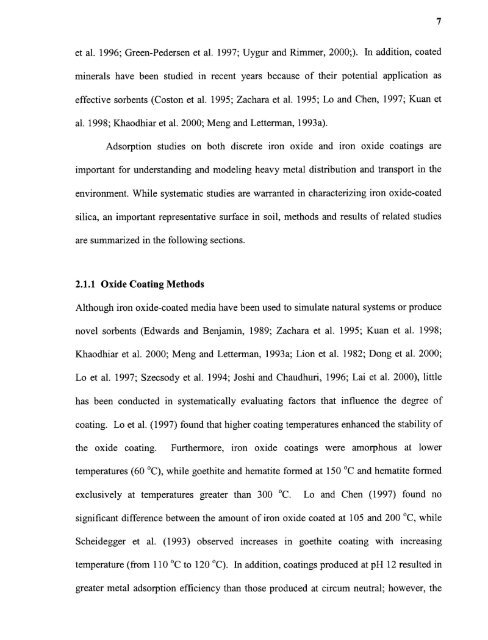Heavy metal adsorption on iron oxide and iron oxide-coated silica ...
Heavy metal adsorption on iron oxide and iron oxide-coated silica ...
Heavy metal adsorption on iron oxide and iron oxide-coated silica ...
You also want an ePaper? Increase the reach of your titles
YUMPU automatically turns print PDFs into web optimized ePapers that Google loves.
7et al. 1996; Green-Pedersen et al. 1997; Uygur <strong>and</strong> Rimmer, 2000;). In additi<strong>on</strong>, <strong>coated</strong>minerals have been studied in recent years because of their potential applicati<strong>on</strong> aseffective sorbents (Cost<strong>on</strong> et al. 1995; Zachara et al. 1995; Lo <strong>and</strong> Chen, 1997; Kuan etal. 1998; Khaodhiar et al. 2000; Meng <strong>and</strong> Letterman, 1993a).Adsorpti<strong>on</strong> studies <strong>on</strong> both discrete ir<strong>on</strong> <strong>oxide</strong> <strong>and</strong> ir<strong>on</strong> <strong>oxide</strong> coatings areimportant for underst<strong>and</strong>ing <strong>and</strong> modeling heavy <str<strong>on</strong>g>metal</str<strong>on</strong>g> distributi<strong>on</strong> <strong>and</strong> transport in theenvir<strong>on</strong>ment. While systematic studies are warranted in characterizing ir<strong>on</strong> <strong>oxide</strong>-<strong>coated</strong><strong>silica</strong>, an important representative surface in soil, methods <strong>and</strong> results of related studiesare summarized in the following secti<strong>on</strong>s.2.1.1 Oxide Coating MethodsAlthough ir<strong>on</strong> <strong>oxide</strong>-<strong>coated</strong> media have been used to simulate natural systems or producenovel sorbents (Edwards <strong>and</strong> Benjamin, 1989; Zachara et al. 1995; Kuan et al. 1998;Khaodhiar et al. 2000; Meng <strong>and</strong> Letterman, 1993a; Li<strong>on</strong> et al. 1982; D<strong>on</strong>g et al. 2000;Lo et al. 1997; Szecsody et al. 1994; Joshi <strong>and</strong> Chaudhuri, 1996; Lai et al. 2000), littlehas been c<strong>on</strong>ducted in systematically evaluating factors that influence the degree ofcoating. Lo et al. (1997) found that higher coating temperatures enhanced the stability ofthe <strong>oxide</strong> coating. Furthermore, ir<strong>on</strong> <strong>oxide</strong> coatings were amorphous at lowertemperatures (60 °C), while goethite <strong>and</strong> hematite formed at 150 °C <strong>and</strong> hematite formedexclusively at temperatures greater than 300 °C. Lo <strong>and</strong> Chen (1997) found nosignificant difference between the amount of ir<strong>on</strong> <strong>oxide</strong> <strong>coated</strong> at 105 <strong>and</strong> 200 °C, whileScheidegger et al. (1993) observed increases in goethite coating with increasingtemperature (from 110 °C to 120 °C). In additi<strong>on</strong>, coatings produced at pH 12 resulted ingreater <str<strong>on</strong>g>metal</str<strong>on</strong>g> <str<strong>on</strong>g>adsorpti<strong>on</strong></str<strong>on</strong>g> efficiency than those produced at circum neutral; however, the
















